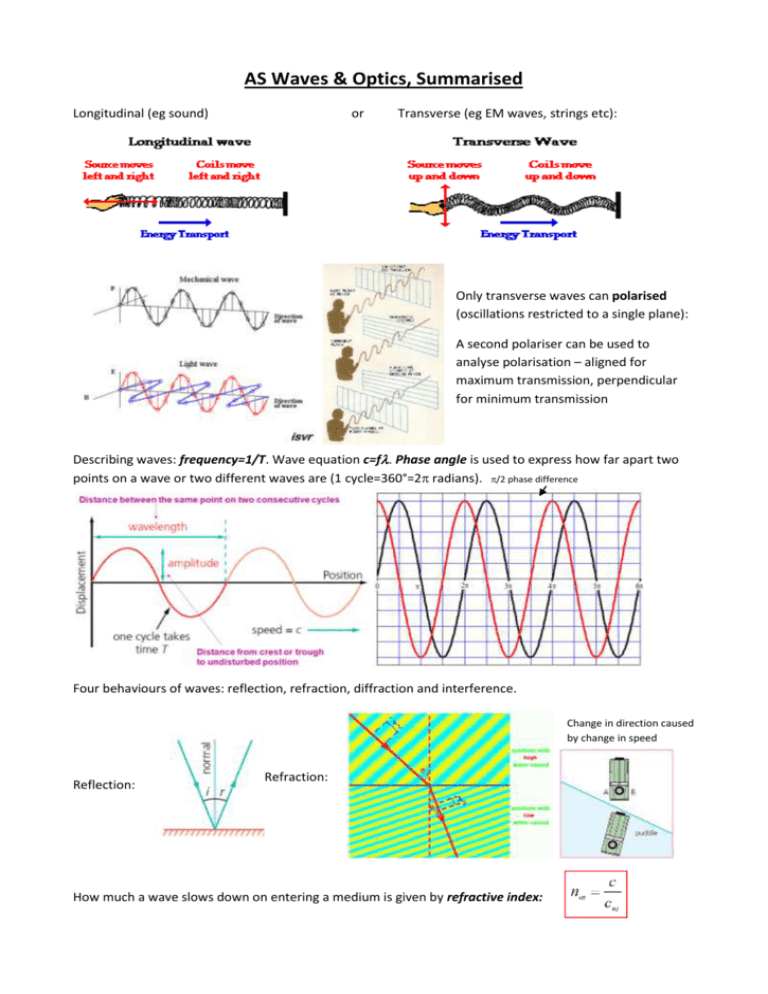AS Waves & Optics, Summarised
advertisement

AS Waves & Optics, Summarised Longitudinal (eg sound) or Transverse (eg EM waves, strings etc): Only transverse waves can polarised (oscillations restricted to a single plane): A second polariser can be used to analyse polarisation – aligned for maximum transmission, perpendicular for minimum transmission Describing waves: frequency=1/T. Wave equation c=fPhase angle is used to express how far apart two points on a wave or two different waves are (1 cycle=360°=2 radians). /2 phase difference Four behaviours of waves: reflection, refraction, diffraction and interference. Change in direction caused by change in speed Reflection: Refraction: How much a wave slows down on entering a medium is given by refractive index: We can work out where refracted rays go using Snell’s Law: For waves travelling from a denser to less dense medium (only), have critical angle and total internal reflection: Cladding reduces crosstalk and bending loss, and narrows acceptance angle and hence dispersion (pulse spreading) dispersion Diffraction and interference effects can be explained using the principle of superposition: when two waves meet the total displacement at a point is equal to the sum of the contributing displacements. If they reinforce each other it is called constructive interference, if they cancel out it is destructive interference. For constructive interference, phase difference =0, 2, 4 etc. For destructive interference, phase difference =, 3, 5 etc. Diffraction is the tendency of a wave to spread out when it passes through a narrow gap or around a small obstacle. The narrower the gap/obstacle the more the wave spreads. Most efficient diffraction happens when size of feature is comparable to wavelength. Circular aperture/obstacle diffraction pattern The single slit diffraction pattern consists of a bright central maximum surrounded by fringes on either side. The fringes are equally spaced and half the width of the central maximum. Minima are due to destructive interference of waves travelling different distances from different points along the aperture. Diffraction fundamentally limits the resolution of all imaging systems. Longer wavelengths diffract more than shorter. Need to be able to describe a white light diffraction pattern: superposition of differently spaced fringe patterns of different colours, so bright white central maximum, the fringes showing colours of the spectrum with blue on the inside and red on the outside. Fringes quickly merge to grey as you move off axis. Two source interference can be observed with sound, microwaves, water waves etc but is exemplified by Young’s double slit experiment: Destructive dark Constructive bright Single slit is included to ensure light is coherent: all waves have a constant phase relationship. Light diffracts and illuminates double slits. Diffracts through two slits – where the diffracted waves overlap they interfere. Light and dark fringes are seen: bright when waves arrive from two slits in phase (path difference =n), dark when waves arrive out of phase (path difference=(n+0.5)). where is wavelength, s is slit separation, w is fringe separation and D is distance from slits to observer. Only holds if w<<D: do not use for microwaves! If slits move apart, the fringes move closer together. If a shorter wavelength is used, the fringes move closer. If narrower slits are used the overlap region (so number of fringes) increases and the intensity decreases, but the pattern remains the same. Fringe intensity pattern (solid red) is sinusoidal (dotted red), but modulated with the single slit diffraction pattern (blue). White light fringes have white central maximum and coloured fringes, blue on the inside. Diffraction gratings consist of many closely-spaced slits and produce an array of bright maxima with darkness in between. These are called diffraction orders. Diffraction gratings can be used to analyse the spectrum of light, as the angle at which a maximum appears depends on the wavelength of light. You need to be able to derive the grating formula in the exam. If the red rays show the direction of waves from two adjacent slits in the grating travelling to the nth order maximum: For constructive interference the path difference QY must be a whole number of wavelengths. QY=n. From the triangle PQY we can see that QY=dsin, so we have: Remember that is the angle between the zero and nth order maxima. cannot be greater than 90°, so there are a finite number of bright maxima that can be produced at a given wavelength. The maximum order number n is found by rounding d/ down to the nearest integer, producing 2n+1 orders altogether. Standing waves are an extended oscillation which stores energy (it is not transferred). Examples include vibrating strings and columns of air – how most musical instruments work. Standing waves are characterised by places along their length called nodes, where the is never any displacement, and antinodes, where there is maximum displacement. The distance between two nodes or antinodes is half a wavelength of the wave. The phase difference between two points on a standing wave is zero if they are between adjacent nodes or separated by an even number of nodes, if they are separated by an odd number of nodes. We explain standing wave formation as due to the interference of two identical waves travelling in opposite directions. As they pass through each other they alternately reinforce and cancel each other out. Standing waves on a string For a given medium only certain resonant frequencies will produce standing waves. The relationship between these frequencies depends on what happens at the boundaries of the medium. For waves on a string both ends must be nodes and standing waves have frequency f, 2f, 3f etc and wavelength /2, , 3 /2 etc. (For standing waves in a pipe an open end must be an antinode and a closed end must be a node). For a closed column the fundamental wavelength is 4L and only odd harmonics are produced. For an open column the fundamental wavelength is 2L, all harmonics are produced.







